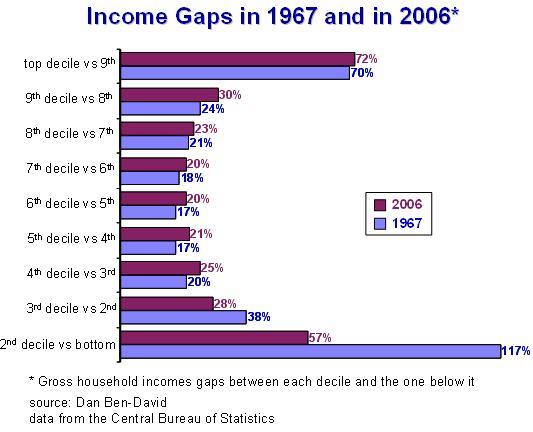|
PDF file
published
in Haaretz on January 7, 2008.
A State of Inequality
by Dan Ben-David “Which country today has the greatest
equality? ... If we confine ourselves to the non-communist world, it has been
suggested that the new state of Israel may lead the list.” So wrote the Nobel laureate, Paul Samuelson, in
his book, “Economics” – a text that became the “bible” of every first year
economics student in the Western world during the fifties, sixties and part of
the seventies. This is how Israel was
introduced to an entire generation of economists by one of the most important
leaders in the field. Today, the Israel that will be
celebrating its 60th birthday is less “new”, and to the title of the list that
it currently leads it is necessary to add the prefix “in-”. A badge of honor – it is not. There is little argument about the
need to grant compensation for excellence as a means of providing incentives
for its achievement. Similarly, it makes
no sense that envy should become the binoculars through which the majority view
society’s most successful. But along
with yesteryears’ socialist bathwater, we appear to have also thrown out our
community conscience and social compass.
Salaries beginning with the number 7 and followed by 3 zeroes reflect
the national average. But in a country
where that is the average, monthly salaries that begin with the same number, but
are followed by 5-6 zeroes, long ago surpassed – in most cases – not only the
boundaries of propriety, but also the boundaries of economic rationale Few in Israel remain unconvinced that
these insane salaries are the source of our leap from the forefront of
egalitarian countries in the sixties to head the list of most unequal Western
countries this decade? The problem is
that this is just another example of the easy life that we make for ourselves
when the issue of inequality is raised and the focus invariably turns to those
maddening examples, instead of to the actual crux of the problem. As indicated in the diagram, the
largest gaps are between the two polar income deciles and the rest of society. But what is the source of the increase
in inequality since the 1960s? As a matter of fact, the gap between
the second income decile and the bottom decile dropped from 117% in 1967 to 57%
in 2006. The gap between the third
income decile and the second decile also fell, from 38% to 28%. Gaps between every one of the other deciles
grew. Where was the largest increase in
income disparity? Not between the
highest income decile and the 9th decile immediately below it. This gap was large in 1967, and during the
next 4 decades, it grew from 70% to “only” 72%. But, in contrast with conventional
wisdom, most of the increase in Israeli income gaps did not result from the
very wealthiest leaving the rest of us in the dust, nor did it come from society
discarding its very poorest farther and farther behind. The bulk of the increase in income disparity
came from gaps that became increasingly wider between each of the middle income
deciles. In the central boulevard of
Israeli society, each one of the income lanes has moved farther and farther
from one another. The time has come to
understand this and to begin dealing with it. comments
to:
danib@post.tau.ac.il
|
